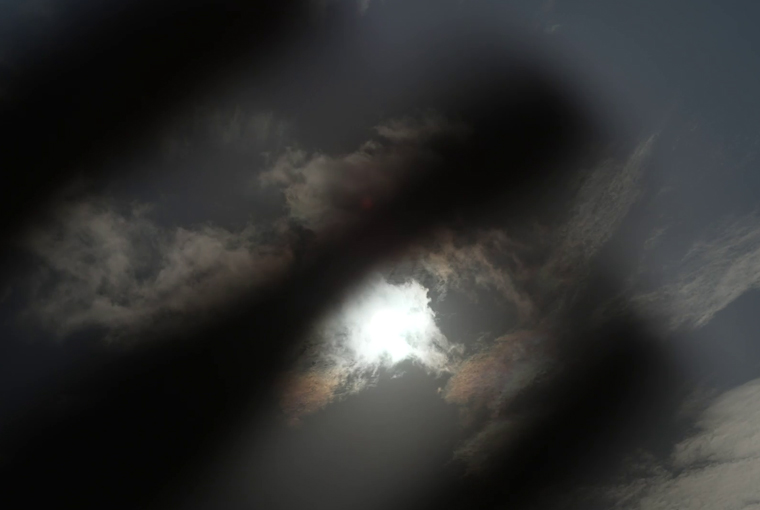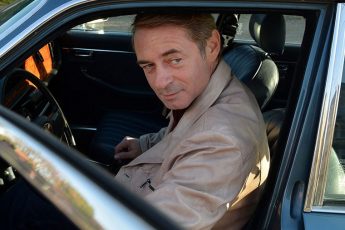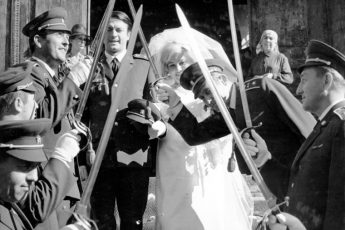Space Weirdness
Lea Petříková’s If I Ever Lose My Eyes (2023)
Vol. 143 (March 2024) by Martin Kudláč
The feature-length debut of Czech visual artist and filmmaker Lea Petříková If I Ever Lose My Eyes premiered at the Ji.hlava International Documentary Film Festival. Petříková previously authored the experimental short After the Wizard (Podle čaroděje, 2020), a reinterpretation of a lost film by the artist Alice Rahon from the late 1940s. Going far beyond a mere attempt at a reconstruction, Petříková’s homage explores the circumstances of the original’s creation, which become a basis for reflecting on the nature of artistic work, the position of the artist, and the capacity to capture the invisible more broadly speaking. Her feature debut is more of a traditional documentary slightly bent towards the experimental, but it does extend one of the motifs of her short film, namely the capacity to capture the invisible.
If I Ever Lose My Eyes is constructed as an omnibus, weaving together Petříková’s shorter documentary works that are inserted as chapters. The film serves as a travelogue, engaging with local lore and delving into the concept of invisibility within both physical spaces and the cinematic medium itself. Her History of Shrouded Screen (Dějiny plátěného filmu, 2021), which has been showcased independently, serves as one segment. It centers around Ladislav Valeš, a key figure in the Movement of Canvas Film. Valeš regards the medium of film as comparable to the Turin Shroud, capable of capturing not mere appearances but the very essence beneath the surface of objects.
Petříková interlaces Valeš’s image and presence into the monochromatic vistas surrounding Klapy. The natural and constructed contours – bridges, tombstones – echo the complex architecture of the human psyche, artfully merging tangible reality with imaginative constructs, and conscious thought with the undercurrents of the subconscious. The segment exemplifies the documentary’s overarching theme: the pursuit of capturing the intangible, both in the realm of film and the broader scope of human experience.
The film unfolds through distinct segments, each rooted in a unique locale and tethered to its specific folklore. This travelogue showcases a tapestry of intriguing and mysterious sites: a mountain believed to be the abode of the devil, a stone bearing what is thought to be the footprint of Christ, a structure speculated to be an extraterrestrial landing ramp, and a crypt adorned with ancient inscriptions. The segments are connected by Petříková’s wanderings in a cave that serve as a metaphorical thread that weaves through these varied landscapes and realities. The passage through the cave functions as a leitmotif, symbolizing a deeper exploration of the physical and the mystical and thus offering a lens through which to perceive the interconnectedness of different realms and the layers of meaning they hold. The director crafts a documentary that is as much about the exploration of physical spaces as it is an inquiry into the ethereal and unseen, challenging the audience to contemplate the realms beyond the visible.
Upon arriving at each location, Petříková adopts a relatively traditional documentary approach, focusing on observing her surroundings. She engages with the environment either by posing questions about the context or by allowing locals to share the legends of the place, such as those surrounding the supposed extraterrestrial landing ramp or the ancient crypt. This collection of peculiar locales gradually transforms into a psycho-geographic journey, prompting reflections on the potential of physical sites to evoke historical, spiritual, and emotional responses. This nexus of interaction suggests that the ordinary can attract or reveal the unseen or hidden.
The documentary thus serves as a probe into the interplay between imagination and reality, proposing that our collective perceptions and narratives endow reality with form and substance. In traversing this landscape of myths and memories, Petříková’s work posits that reality itself is not merely a fixed backdrop but is continually molded and defined by the collective imagination. Through this lens, the film explores the notion that the tangible world we navigate is inextricably linked to the intangible realms of belief, story, and thought, making a case for the power of collective myths to shape our understanding and experience of reality.
If I Ever Lose My Eyes also serves as a contemplation on the medium of film, albeit in a manner that is more implicit and less metatextual than Petříková’s more experimentally inclined After the Wizard. The experimental aspect of the documentary If I Ever Lose My Eyes is embedded in its interpretative approach to the subjects, themes, and motifs that emerge from the exploration of unusual locations. The peculiarity of these places is derived not from their physical attributes but from the narratives, myths, and legends associated with them, and how these narratives extend into the mental and emotional realms of the audience, distinguishing it from dark tourism, which is primarily connected to specific architectures and artifacts that tend to be associated with certain locales.
The uniqueness of the sites in If I Ever Lose My Eyes does not lie in their tangible qualities but in the intangible legends they attract and embody, inviting viewers to ponder the ways in which stories and myths shape our perception of reality. Through this exploration, the documentary underscores the power of legend and narrative to imbue places with a sense of otherness, turning ordinary locations into sites of rich imaginative potential. In doing so, the director not only explores the relationship between places and perception but also reflects on how film can mirror the complex interplay between the tangible world and the realms of imagination and myth.
Petříková’s stylistic and formal choices, traditional yet imbued with themes of analogue psychedelia and altered states of consciousness, complement the film’s thematic explorations. If I Ever Lose My Eyes delves into the essence of perception, the boundless power of imagination, and the unseen forces that spring from our collective dreams and stories. This thematic direction is intrinsically linked to the medium of film, echoing the metaphor of the Turin Shroud with greater emphasis. Through this lens, the director’s journey into bizarre tourism examines places marked by an unusual imprint on reality.
The physical and visible imprints of these locations serve as catalysts, provoking and nurturing our personal and collective imagination, thereby crafting alternative realities. In this sense, Petříková’s exploration of these peculiar sites transforms bizarro tourism into a sort of psychedelic, altering perceptions and distorting reality for those who immerse themselves in the strange energies these places are believed to harbor. The documentary positions itself as a reflection on how places marked by legend and myth can influence our perception, suggesting that the power of these stories to shape reality is akin to a psychedelic experience that alters our understanding of the world around us and unleashes the unseen forces that permeate it.




Leave a Comment